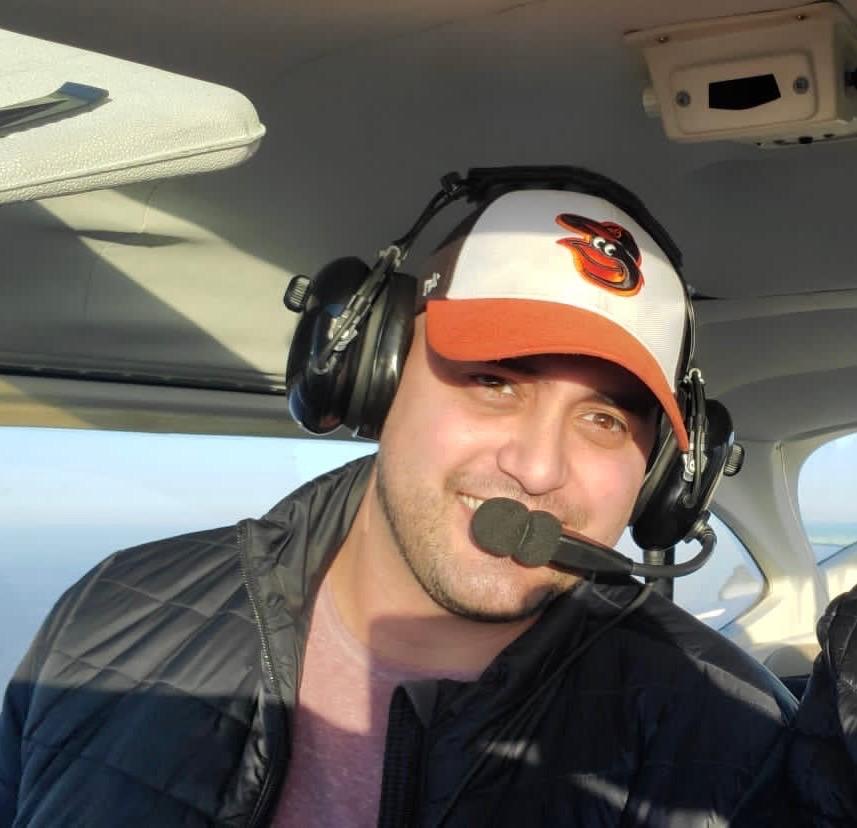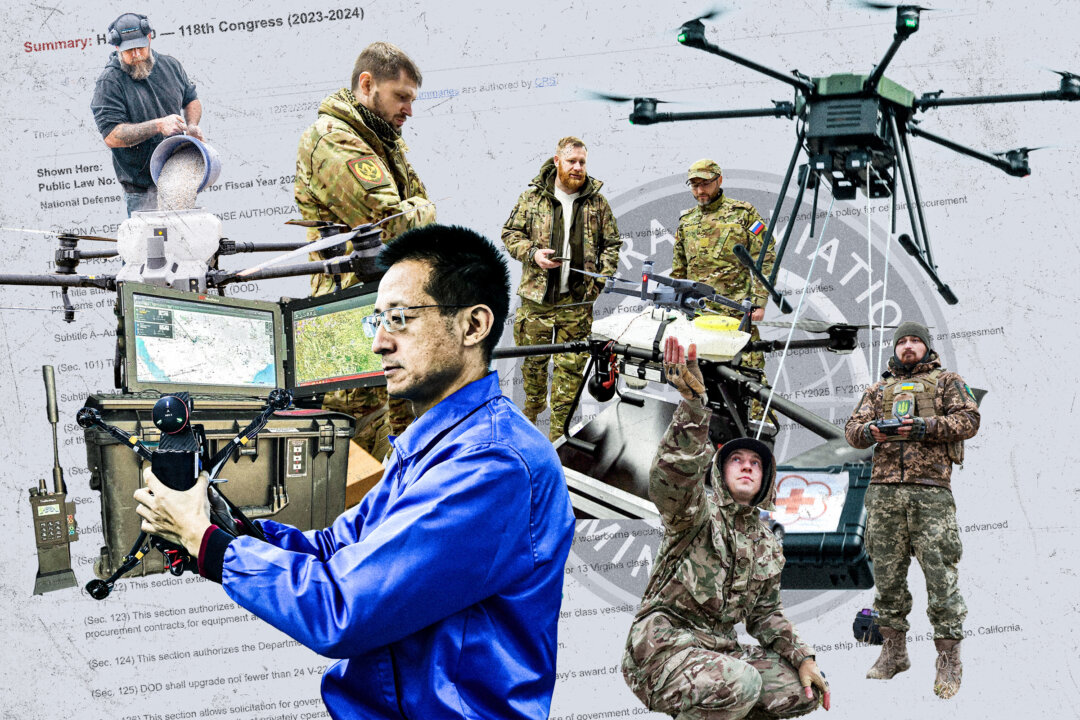For the past decade, Jennifer Krazinski felt safe living in a home “tucked away, off of a dirt road,” in Hewitt, a northern New Jersey suburb.
But what she recently saw in the night sky left her disquieted.
Near her house, Krazinski noticed flying objects with blinking red-and-white lights, emitting a whirring sound.
After three consecutive nights in mid-December 2024, “I stopped looking for them because it just was overwhelming,” she told The Epoch Times. “This makes me uneasy.”
Krazinski worried that someone was using drones to collect information for some nefarious purpose. But she decided against alerting authorities already inundated with similar reports of apparent drone sightings.
Weeks later, specific answers elude Krazinski and thousands of other Americans who spotted Unidentified Anomalous Phenomena (UAP).
Reports came from at least a half-dozen U.S. states since mid-November 2024 and sparked a wave of concern.
After government officials and drone experts gave non-threatening explanations for nearly all the sightings, the hoopla over so-called “mystery drones” dissipated. However, questions lingered.
President-elect Donald Trump has promised that, soon after his Jan. 20 inauguration, he will release more details about the drone sightings; he said it was “ridiculous” that federal officials had been so tight-lipped.
Because of the attention, the public is more aware of drones—a plus for U.S. drone-makers and sellers.
Drone industry leaders also say the incidents underscore an ongoing dilemma: How to balance security needs and airspace-use restrictions against the drive to innovate drone capabilities and uses?
The need to fine-tune drone regulations and procedures is becoming more critical, considering how fast the industry is growing, experts said.

The Federal Aviation Administration (FAA) had registered more than 1 million drones as of last month.
And drone use is expected to continue surging.
Worldwide drone sales now total about $30 billion per year; in 10 years, that figure could burgeon to nearly $224 billion, according to Fact.MR’s market research.

Allan Evans, CEO of Unusual Machines, an Orlando-based drone technology company, told The Epoch Times that the spate of sightings dramatically changed Americans’ perceptions of drones.
The incidents also exposed “a really big gap in airspace management:” a need to better identify, track, and coordinate drone use,” Evans said.
“And people are interested in solving that, rather than just dismissing drones as toys … a novelty item.”
People also are now interested in figuring out “how to organize and use these tools and handle concerns over them being used the wrong way,” Evans said, calling the “toys-to-tools” drones perception “a major shift” in American society.
He cited another realization that has settled in: “I think it’s the first time we’re like, ‘Oh yeah, okay, drones are everywhere all the time.’”
Unusual Machines, which strongly focuses on the consumer drone market, attracted a lot of first-time buyers this past year, Evans said.
Although sales data were not yet releasable, Evans said the drone sightings seemed to have stoked much of the new enthusiasm.
Evans and three other industry professionals told The Epoch Times that citizens and government leaders are justifiably concerned about UAP sightings and drone activities.
However, they also cautioned against jumping to conclusions or panicking based on flawed, distorted, or limited information.
These experts addressed inaccurate claims about drones and suggested how government agencies might handle drone-related issues better.
About the Sightings

Gabriel Garcia, technical director for SPS Aerial Remote Sensing, a Texas company specializing in counter-drone technology, said he thinks people were filing a lot of false reports, unintentionally.
People who are unfamiliar with the nighttime appearance of various aircraft may have misidentified some crewed aircraft as unmanned drones, he said.
Many types of aircraft, including drones, are equipped with white, red, and green lights to aid navigation and avoid collisions. Numerous witnesses reported seeing these lights on the unidentified objects.
Garcia believes authorities know a significant amount of information about the suspected drones.
That’s because the FAA requires drones to be equipped with “a sort of virtual license plate,” which broadcasts a traceable signal, Garcia noted.
That signal provides a lot of data, he said, including GPS coordinates of the drone’s pilot, timestamped actions, altitude, and speed.
Some of the aircraft that aroused suspicions may have been flown by operators who were ignorant of regulations or careless about drone use, Garcia said.
Concerned citizens wondered why authorities didn’t “just shoot them down” to examine them. But Garcia said that would be unsafe, unnecessary, and illegal without special permission.

First, there’s a “grave risk” that innocent people can be injured by ammunition gone astray or falling debris, Garcia said.
Federal law forbids damaging or disabling aircraft, including drones; violations carry heavy penalties. Although police in Long Island, New York, late last year obtained authority to shoot down the drones.
Rather than shoot the drones, authorities can remotely take over control of a drone. “They can tell it where to go and where to land with a much, much safer outcome,” Garcia said.
Another misconception is that some of the drones were reportedly bus-sized.
Jeff Thompson, CEO of Red Cat Holdings, a Department of Defense (DOD) drone contractor in Nevada, said: “There’s not a drone configuration out there that can make a small bus fly like a small drone you see at the beach; that just doesn’t exist.”
Thompson told The Epoch Times that the inaccurate description took hold because “everyone just started repeating it, and it became like a thing, even though it wasn’t true.”

‘Not Enemy Drones’
Many people wondered aloud whether foreign adversaries deployed the suspected drone swarms as a spy operation. Thompson refuted that notion.
“These are not enemy drones,” Thompson said. “There’s no way it was an enemy. They wouldn’t put on FAA lighting … that’s just ridiculous—or they’re the dumbest enemy.”
Drones used for reconnaissance or other military missions fly without lights, he said; these drones are even undetectable by a person wearing night-vision goggles.
“Our drones are stealth, and you want them stealth,” Thompson said.

Robert Newcomb, a Utah-based weapons engineer and DOD contractor who works with drones, agrees that many UAP reports can be chalked up to misidentifications of manned aircraft or heavenly bodies, such as pulsars—rotating stars.
Based on Newcomb’s career knowledge, the reported objects seem to be “nothing out of the ordinary,” he said.
Newcomb said the sightings didn’t set off alarm bells for him.
“Usually, if it’s going to be a threat, they’re going to act quickly,” he said. The drones caused no apparent harm as they hovered or flitted about the sky for prolonged periods.
Further, Newcomb said, U.S. agencies have capabilities for detecting and engaging threats in airspace.
“Should we be fearful? The answer is a hard ‘no,’” he said. “But there’s a caveat to that.”

Valid Concerns
He is worried about “the unknown threats that have come over the border” in recent years.
“There’s likely hundreds of terrorists in the country who are probably planning nefarious acts,” Newcomb said. “Whether they’re going to use drones or other means, that’s unknown.”
And drones, too, are illegally crossing the U.S.–Mexico border, Garcia said. His company has partnered with certain U.S. agencies to detect, track, and identify unauthorized drones.
“We’re looking at activity happening every single day: Drones crossing the border, drones getting used by the cartels to provide surveillance on border control positions and be able to route the human trafficking operations,” Garcia said.
Technology of any kind can be misused, the experts noted, adding that people are naturally curious about new advances and tend to be leery of them.
“Do you remember when cellphones first had a camera? At the time, there were all kinds of privacy concerns around it,” Evans said.
“But I think it worked out OK, right? Like, there’s always going to be resistance to these changes, and there’s always going to be very valid concerns.”
Initially, people worried that drone operators would be spying on them in their homes.
Noting that drones can be used by law enforcement, hospitals, and package-delivery businesses, Evans said people also are starting to recognize that drone management is “not just an FAA problem.”

He said the issue now is “How do these different agencies all coordinate?”, ranging from local police to state personnel and the federal government.
New uses for drones are emerging frequently, he said, including transporting a flotation device to a drowning victim.
“But you can’t do it unless there’s rules around doing it and coordinating the airspace,” Evans said, noting that helicopters or other aircraft might also need to fly near such an emergency scene.
“I think you’re going to see more and more really great applications as we get better and better at it.”
Signs of Improvement
Policymakers appear to be heading in the right direction—in a bipartisan manner, Evans said, noting that several proposals have either been approved or are in the works to improve airspace management and tighten security.
On Jan. 2, Michael Robbins, head of a drone industry advocacy group, issued a statement urging federal officials to end U.S. reliance on “unsecure” technologies from Chinese-subsidized companies “and to invest in U.S. and allied products and support security and fair market competition.”
Commenting on proposed new rules governing drones, Robbins, president of the Association for Uncrewed Vehicle Systems International, said: “We stand ready to work closely with the incoming Trump administration to generate a stronger, more secure drone technology supply chain.”
President-elect Donald Trump is slated to take office on Jan. 20; his son, Donald Trump Jr., serves on the advisory board for Evans’ company, which says it is committed to “onshoring U.S. drone component manufacturing.”
Thompson, who founded Unusual Machines and now directs its board, points out that the U.S. government has been combating security concerns about foreigners’ use of drones against the United States.
Many people feared that Chinese-made drones and drone parts might be used to gather intelligence that would jeopardize the United States.

In response, the U.S. government began taking steps in 2018 to end the federal government’s use of Chinese drones and Chinese-made drone parts, he noted.
In 2023, the American Security Drone Act “basically stated that anyone that receives a federal penny cannot buy Chinese drones or parts and has to get rid of what they have,” Thompson said.
Because of drone use in the Ukraine–Russia war, “everyone realizes how important these drones are for war,” Thompson said, “and nobody wants Chinese drones flying around the United States, mapping out the entire infrastructure, because they do actually transmit information back to China servers for you to be able to log onto your drone.”
Experts Offer Suggestions
Still, drone regulations need to be streamlined to ensure progress, the experts agree.
“Our nation’s defense is going to depend on drones going forward,” Thompson said.
Newcomb fears that over-regulation will “stifle innovation … and how the technology advances.”
He suggests that “instead of forcing every drone to be tracked, we just offer an airspace for them to operate in.”
Evans commended the FAA for its emphasis on safety, which enables Americans to travel more safely in an airplane than in a car, federal data and numerous studies show.
Likewise, Evans believes the FAA is “doing a really good job of balancing the need for innovation” against security concerns.

“They’re doing a lot of exceptions. They’re doing a lot of test programs. They’re enabling a lot of the exploratory stuff,” he said.
At the same time, the FAA is concerned about avoiding “an overzealous cowboy environment that could lead to really dangerous things, with stuff falling out of the sky,” Evans said.
All four drone experts who spoke to The Epoch Times were unanimous in their recommendations that federal agencies communicate better with each other.
Garcia noted that the FAA “has no authority to take down a drone,” and therefore must rely on help from other federal agencies.
Newcomb said that officials need to answer questions from citizens more directly, rather than deflecting, and they can acknowledge that security concerns prevent them from disclosing certain details.
Garcia and Newcomb emphasized a need for the government to invest more heavily in counter-drone technology.
However, the experts concurred that federal agencies seem to be confronting drone-related concerns more effectively.
“I think we’re on the path to solving it,“ Newcomb said, ”to ensure that our airspace is safe.”




